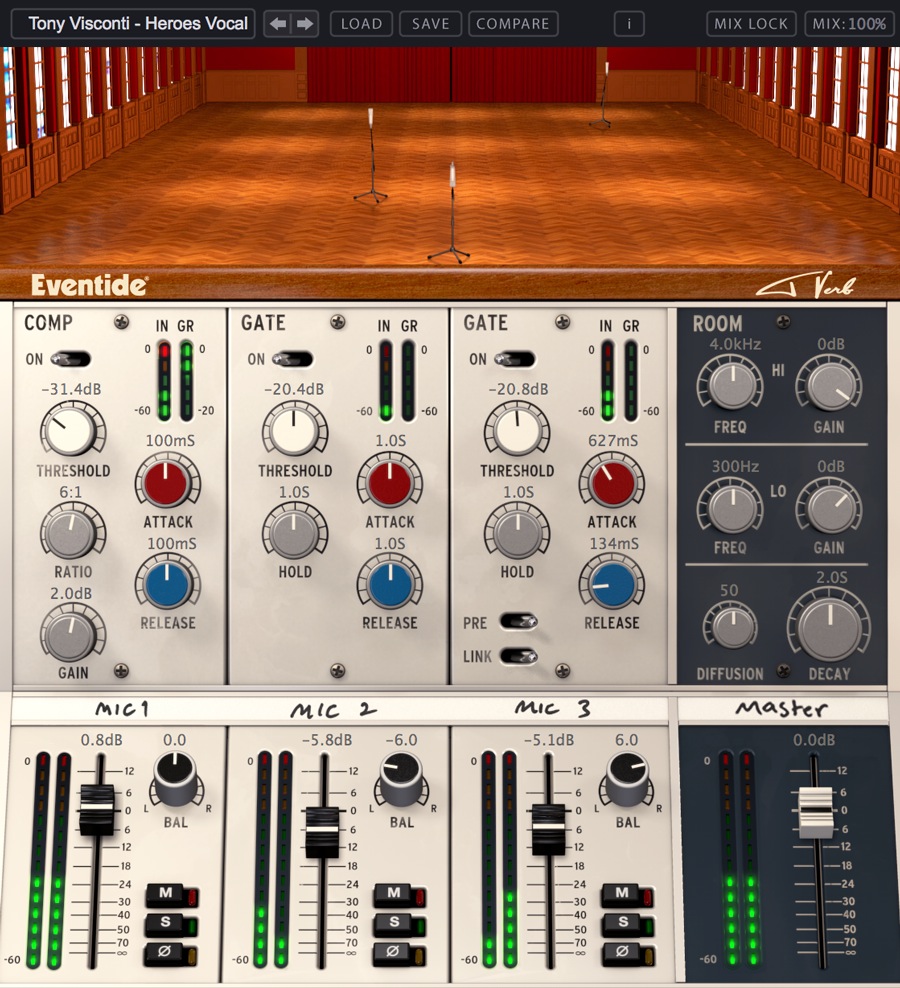New Software Review: Tverb by Eventide
Back in 1977, David Bowie was recording the lead vocal for the title track of his Heroes album in Berlin’s massive Hansa Studios. Producer Tony Visconti had one unused track left on the tape machine, and was looking to create a unique sound and reverb for Bowie’s vocal. But Visconti had a problem: He was running low on tracks, so he couldn’t record the vocals and then send them out to a reverberant chamber later on, as he was accustomed to doing at the time.

The GUI of Tverb sports an appealing vintage aesthetic while paying homage to the historic Hansa Studios.
Visconti came up with an ingenious solution. He set up three mics: One for Bowie to sing into, a second mic around 15 feet away, and a third mic about 50 feet farther back into the room to capture its rich ambience. Noise gates were applied to the second and third mics, and adjusted to gradually open as David sang louder. Then, all three channels were summed on the console and sent to the last open channel on the tape machine.
Eventide has captured this unorthodox reverb effect with Tverb, a plug-in that features three lush, independent reverbs in one, modeled after Visconti’s unique mic setup.
Features
Tverb offers selectable polar patterns and compression on microphone one, and adjustable gates on mics two and three. With added stereo capabilities, the plug-in allows you to forge immersive new effects and soundscapes, along with the ability to automate the distance between the mics.
At the heart of the plugin are some custom Eventide reverb algorithms with control over EQ, diffusion, and decay. Additional features include console modeling, full automation support, a pair of linkable pre- or post-reverb gate modules with control over the seed at which the gates close, and a “Mix Lock” feature that allows for scrolling through presets or settings while keeping the wet/dry mix constant.
In Use
The TVerb plug-in responds like a great room reverb with a lot of options to tweak away at. I found it works well for vocals, but where it really helped was on a mix where we had to close-mic strings due to fears of drum leakage.
Hansa Studios in Berlin is used mostly for jazz and orchestral recordings, and Tverb added a really nice glue to the strings when I bused all of them into a single instance of Tverb. Additionally, I found Tverb to work very well on guitars; it excelled in recreating the authentic feeling of a loud amp being placed within a room. Check out this video to hear how Tverb sounds on guitar.
Automating the mic positions within the room is a very pleasant experience with Tverb, thanks to the vibrant visual display of where they sit in relation to the main microphone. Placing the mics close when a vocalist sings an intimate verse, then pushing them 25-50 feet away when the vocals open up for the chorus adds a wonderful dimension to a recording.
While this reverb plug-in only simulates one room, it does a great job and is surprisingly versatile when compared to similarly priced IR convolution reverbs available on the market today.
The other added benefit of Tverb is how quickly you can load what would otherwise be a very time-consuming setup of three mics and two noise gates. This type of dynamic reverb really adds an authentic 70’s vibe to modern recorded material.
To Be Critical
Tverb is a really solid plug-in, and it’s hard to find anything critical to say about it. Using it in Ableton, I found that it only used up about 6-10% of my computer’s CPU (and this is on a pretty old 2011 MacBook Pro).
The interface is intuitive, there are many knobs to twiddle away at, and a great array of finely-tuned presets by amazing engineers, producers, and mixers including Erin Tonkon, Ken Rich, and Visconti himself.
At $249 however, Tverb is fairly expensive compared to other reverb plug-ins by companies like Valhalla DSP, Lexicon, and U-He that are far less niche in their focus.
Summing it Up
Overall, Tverb is an intuitive, natural-sounding room reverb from which you can coax many sweet sonic textures and complex gated space sounds.
If you are hoping to get massive tunnel-like reverbs, it won’t be easily accomplished with this plug-in. However, Eventide also makes a fantastic plug-in called Blackhole for when you need your music to sound like it’s being played in massive cathedrals or otherworldly halls.
I highly recommend Tverb for adding life and space into your vocals, drums, and orchestral instruments. You can demo it for free (along with many other plug-ins) via Eventide’s website.
While there is certainly no shortage of great reverb plug-ins already available on the market, Tverb stands in a category of its own, and can help you create a unique dimension in your mixes.
Please note: When you buy products through links on this page, we may earn an affiliate commission.






